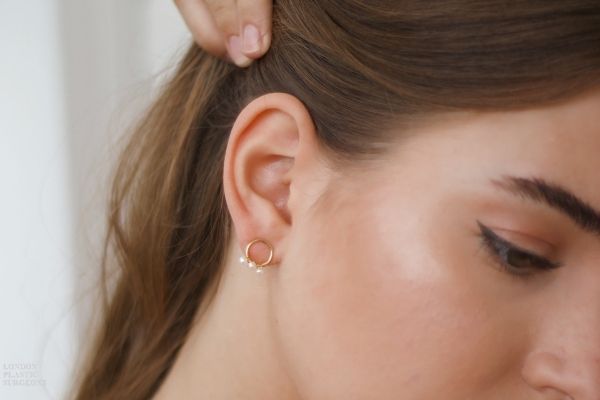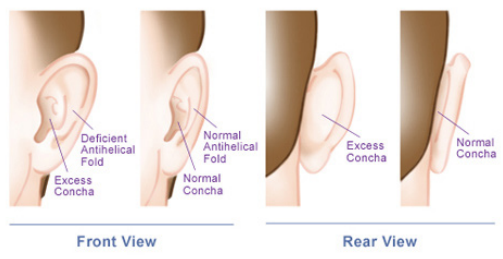Ear Correction – Otoplasty Ear Surgery in London United Kingdom

Having prominent ears can make you self-conscious and affect your confidence. Many people often feel that their ears are too large and an unfolded ear cartilage can make your ear stick out. Sometimes it’s the ear lobes themselves – they can be oversized and quite floppy. These problems are all readily resolved with sculpturing and buried stitches. Otoplasty Ear Surgery – Ear Correction or Ear Pinning – can help both adults and children. Mr Mark Gittos Plastic Surgeon is an expert ear surgeon based in London.
Plastic Surgery for Damaged or Ripped Ear lobes – If you have a split your ear lobe or have stretched your ear piercing this can be corrected by a complex local skin flap using special plastic surgical techniques.
What is Otoplasty Ear Surgery?
Otoplasty, commonly known as prominent ear surgery or cosmetic ear surgery, is one of the most common procedures in cosmetic and corrective surgery. Ear deformity in terms of its separation from the head is the most common inherited anomaly among numerous deformities on the outer part of the ear.
Prominent or asymmetrical ears are difficult to hide and represent an aesthetic problem that can become a source of deep dissatisfaction in children, teenagers, but also adults.
Otoplasty is mostly performed during childhood, but people of all ages can undergo this surgical procedure. The growth and development of the auricle end around the 5th year of life, after which it is possible to surgically correct the auricle.
The goal of the operation is to decrease the ears’ prominence, get the natural shape of the ear, and to remove the psychological burden of the patient.
Ear surgery or otoplasty is an aesthetic procedure that:
- corrects the shape of the ear
- changes the size of the ear
- changes the position of the ear
- changes the proportion of the ears

Am I a good candidate for Otoplasty?
Otoplasty can be done when the ears reach their full size, most often after the age of 5. This operation is recommended if the eardrums are placed so that they protrude significantly outside the surface of the head, if the eardrums are larger than the size of the head and if you are dissatisfied with the result of the previous operation.
You might be a good candidate for Otoplasty if:
- You have lower self-esteem due to prominent ears
- You experienced emotional stress and taunting due to the appearance of your ears
- You are at least 5 years old
- You are in good overall health
Download Mr Mark Gittos’ Guide to Facial Rejuvenation Surgery – Surgical and Non Surgical Anti-Ageing

Benefits of Otoplasty Ear Surgery
Ears are typically not the major focal point of one’s face, but if they visibly protrude it can leave some people feeling self-conscious or unhappy about their looks.
An ear correction and beautification intervention will help you not only to change the look of your ears but also your overall appearance, which will definitely affect your self-confidence. And that self-confidence has no price is something that all satisfied patients who have done this operation a long time ago now.
You can expect:
- Proportional and contoured outer ear.
- Permanent results
- An increase in self-confidence
- A feeling of satisfaction and relief for solving this aesthetic problem that has always bothered you.
Otoplasty Ear Surgery Before and After photos
Visit the clinic to see the real patient photo gallery of Before and After Otoplasty surgery photographs representing typical results our patients get. Results depend on individual patient circumstances and can vary significantly.

Otoplasty Ear Surgery Procedure
Since every patient is different, the surgical technique varies based on the type of correction needed. The specific technique chosen by your surgeon will determine the location of the incisions and scars. Otoplasty is most often performed under local anesthesia but can be done under general anesthesia as well.
With ear correction surgery, our patients are often children, and so we use a general anaesthetic to optimise their experience. With adult patients, a local anaesthetic can be used.
After making incisions Mr Gittos can remove excess cartilage and skin from the ears. The cartilage is then folded into the appropriate position and closed with sutures. By carefully reshaping the cartilage and contouring the basic elements of the ear, the desired shape and natural symmetry are achieved. The scars remain completely hidden in the natural crease behind the ear and will often be completely invisible after the recovery period. The procedure usually takes from 1-2 hours, depending on the technique, patient, and the complexity of the procedure.
Afterwards, a small headband type bandage is worn for a few days, and all stitching is of the dissolving type. There is very little discomfort associated with these procedures.
Recovery after Otoplasty Ear Surgery
Recovery from Otoplasty ear pinning surgery is typically very quick, and most patients will not require any time off work unless they are experiencing discomfort or pain.
After the surgery, your ears will be covered with protective bandages to protect the incision area. You will wear the bandage for 24-48 hours. This bandage will be replaced with an elastic band to protect your ears from traumas for the next 5-7 days.
Dissolvable stitches are often used when suitable, and these then dissolve within 7-10 days. Three to four weeks after surgery, an elastic band is worn at night to prevent unintentional ear injuries during sleep.
During the first couple of days of recovery, you might experience some swelling, bruising, itching, and mild discomfort. Your doctor will provide you with painkillers which usually help the most patient to manage pain easily.
You will receive detailed post-operative instructions from your doctor, which should be followed in order to achieve optimal results, speed up recovery, and avoid complications.
Normally, just a couple of hours after the surgery you will be discharged from the hospital. Demanding physical activities and contact sports should be avoided at least for a month.
Most patients go back to their regular activities (school, work) in a week after the surgery.
In the six weeks following your operation, it’s a good idea to wear a protective headband at night, to prevent the ear folding over during sleep. The same applies to children playing or adult sports.
Complications and Risks of Otoplasty Surgery
Incisions are discreetly placed behind the ear and normally settle down without problems although occasionally keloid scars have been noted.
Like all other types of surgery, otoplasty comes with the risk of bleeding, infection, and bad reactions to anesthesia. Typically, for healthy candidates who follow pre-surgery and post-op instructions, risks are minimal.
Some of the risks and complications of ear surgery are:
- Unsightly Scars (scars are permanent but usually successfully hidden inside the natural crest)
- Ear asymmetry
- Changes in skin sensation
- Unnatural look
Your Otoplasty journey

1. Pre-op Consultation(s)
- After you choose the right surgeon, you will attend consultations to talk more about your wishes, expectations, and medical history.
- Medical examinations will be performed, in order for the surgeon to determine which operative technique is the best for you.
- Mr Gittos will explain possible complications, inform you about preoperative preparation, what tests and laboratory findings are needed, what to avoid before surgery, and how to behave after surgery.
2. Ear Surgery
- Otoplasty is a procedure in which the surgeon removes excess skin behind the ear to reach the cartilage. The cartilage will be precisely reshaped, in order to achieve the desired contour of the ear, natural symmetry, and desired shape.
3. Post-op Recovery
- Postoperatively, you will report for regular check-ups in agreement with your surgeon.
- Your surgeon will compare and analyze the results of the surgery. The results of otoplasty are permanent. You will have to follow post-surgery instructions carefully to improve the results and reduce the recovery time.
Otoplasty Ear Surgery Cost and Prices

Every patient is different, therefore the prices vary. You will be given a price quote after your first consultation. Your Otoplasty Surgery quote will include your surgeon’s fee, anesthetist’s fee, perhaps a surgical assistant fee, and the theatre/hospital fees.
Further reading – Medical references
- Otoplasty: Definition, benefits, and what to expect
- Otoplasty – Mayo Clinic
- Ear Surgery | American Society of Plastic Surgeons
- What Is Otoplasty (Ear Surgery)? Recovery Time & Risk
- Otoplasty – an overview | ScienceDirect Topics
FAQ about Otoplasty Ear Surgery

Can Otoplasty change the size of my ears?
- Yes, otoplasty can alter the shape, size, and protrusion of your ears.
Is it possible to perform Otoplasty on only one ear?
- Yes, if only one ear is protruding the surgeon can perform the surgery only on one ear to achieve a balanced look.
Can Otoplasty be combined with other surgical procedures?
- Yes, it can and it regularly is. Perhaps an Eyelid lift or Nose Surgery.
Will Otoplasty improve my hearing?
- No, otoplasty is a solely cosmetic surgery procedure and does not affect ear function.
How noticeable are the scars after Otoplasty?
- The incisions are placed in the natural crease where the ears are connected to the skull, so the scarring is usually unnoticeable. Scarring after Otoplasty reduces over several weeks as it heals, and are typically minimal to nearly invisible for many patients.
Can Otoplasty be revised?
- Yes, if you are unhappy with the results of your Otoplasty, revision is possible after your ears are completely recovered from the first surgery.
How long will I have to wear a headband?
- You should wear a headband for at least 10-14 days after the surgery. After that period, you can start wearing headband only during sleep to reduce the chance of injuries (5-7 weeks).
Is Otoplasty covered by Health Insurance?
- Ear Pinning is considered cosmetic in nature. Otoplasty Surgery is generally not covered by Medicare.
About Mr Mark Gittos FRACS (Plast) – London Plastic Surgeons
Practice locations in London & Essex, UK and Auckland, New Zealand.
Mr Mark Gittos offers high quality, natural-looking cosmetic surgery results and is highly experienced in Breast, Body and Face Surgery having performed over 4000 Surgeries in the last 26 years.
With world-wide expertise Mr Gittos is an expert in breast, face and body surgery for men & women.
Mr Mark Gittos is a leading Specialist Plastic Surgeon and operates a practice in London UK and Auckland New Zealand. His practice focuses on both surgical and non-surgical procedures, each designed to help restore, improve or change a physical characteristic or problem. The first step in every case is to talk through your personal requirements and explore all the options, before deciding on the most effective solution.
Naturally, before any treatment is begun, we will explain clearly the advantages and risk factors; so that you have the information you need to make an informed decision that is best for you. Visit the practice to find out more.

NEXT STEPS
Do your Research
- Read the Website and Blogs relevant to your procedure
- Browse our Frequently Asked Questions including how to choose a Surgeon for your procedure
- Download the Guides to Surgery
What to Bring to your Plastic Surgeon Consultation
- Bring a friend or relative to help discuss the information and your choices
- Take lots of notes and read the documents provided thoroughly
- Want more information before scheduling your consultation?
Book your Initial Surgery Consultation
- A Referral from your GP or specialist is helpful but NOT essential – you can have a consultation without a GP Referral
- Email us or Call in London on 07557 858156 to arrange your surgeon consultation appointment.
- Secure your consultation with Mr Gittos by paying the Consultation Fee in advance
- A consultation with Dr Gittos is £195.
Please contact us to arrange to book a consultation or to speak with our Patient Care Advisor.
Send an enquiry form today or UK phone 07557 858156 during Clinic Hours

